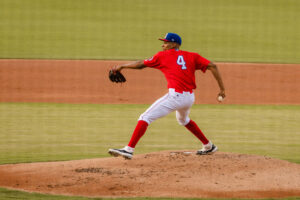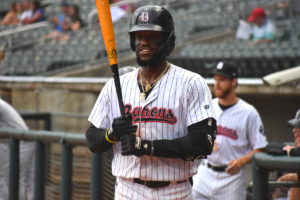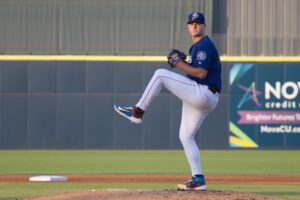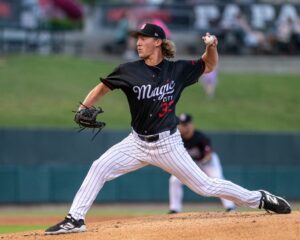FutureSox 2020 Preseason Rankings Roundtable: Writers’ High and Lows
Twice annually, our writers huddle and compile their personal top 30 rankings of White Sox prospects. That’s before the real fun begins however. Questioning, critiquing and sometimes arguing comes next as we try to determine the best possible list for our readers to consume.
The end result is our final FutureSox Top 30 list which is a weighted fusion of our original lists. This article is an on-going series that allows our writers to explain their rationale for a prospect they ranked higher or lower than the general consensus. The first number next to each prospect is the ranking assigned by that writer and the second number is what they were ranked on the actual list.
To read our preseason 2020 top-30 list, you may find it here.
James Fox
Highest: Konnor Pilkington (16th, 17th)
Konnor Pilkington should advance to Double-A Birmingham this year and his future likely depends on the improvement of his fastball. The former 3rd rounder has solid command but he’s lost velocity on his heater. I’m a sucker for southpaws with advanced changeups though and Pilkington’s change is pretty good. He has a pretty good chance to reach the majors and has a floor of a #5 starter in the big leagues. If he puts everything together and improves the fastball though, he could land in the middle of someone’s starting rotation.
Lowest: Blake Rutherford (14th, 13th)
Blake Rutherford falls in the group of advanced minor league outfielders that inhabit the White Sox’s system. I have Rutherford slotting in behind Adolfo, Basabe and Gonzalez. Basabe and Gonzalez get the nod because of their ability to play center field and Adolfo’s raw power potential puts him over the edge. Rutherford is an athlete but hasn’t hit for enough power and likely will be relegated to left field due to his average throwing arm. Early reports from Arizona suggest that Blake Rutherford has put on an extraordinary amount of muscle mass this winter and is ready to improve himself this spring. If Rutherford can develop more power, I’ll be more than happy to be wrong about this ranking.
Mike Rankin
Highest: Gavin Sheets (8th, 12th)
Love me some Gavin Sheets in 2020. Turning 24 in April, Sheets has accumulated over 1,250 plate appearances in 301 Minor League games. His 83 RBI led the Southern League and he also ranked in the top-10 in home runs with 16. Ultimately, his first stint in Double-A resulted in an encouraging 10 percent walk rate and 122 wRC+. It’s about that time he takes the next step.
Power is among the first topics of conversation surrounding Sheets. It’s fair to have concern over the lack of production in that department, especially considering its relevance attached to his position. However, I’d prefer you to look at Sheets as a pure hitter, as opposed to a bat that lacks power.
It appeared Sheets consciously tried to hit for more power in 2019. His average dipped and his strikeout rate increased. Sheets is a player who takes pride in maintaining a disciplined plate approach while limiting the strikeouts and producing hard contact to all fields – especially to his pull side. I’m not worried about the power as long as his hard-hit rate remains intact. With an inviting International League on the horizon, Gavin Sheets is primed to make a leap in 2020.
Lowest: Matthew Thompson (10th, 8th)
The fact I’m lowest on Matthew Thompson despite ranking him No. 10 overall speaks to how highly regarded he is as a prospect. The White Sox were in no rush to implement both high schoolers Thompson and Andrew Dalquist into the professional equation last year. This season will be a great tell as to what the Sox seriously have in the pair of arms.
I ranked Dalquist one spot higher than Thompson. I’m a big fan of Dalquist’s, frame, his under control delivery and also his projectable starter’s repertoire that includes a 91-93 mph fastball, curveball, slider and changeup. He turns 20 in August with room to grow into his listed 6-2, 175-pound build.
When it comes to Thompson, I’m curious to see how his stuff will translate to the professional scene. At 6-3, 195-pounds, the 2019 second round pick offers a mid-90’s fastball and a sharp breaking slider. My concerns, at this point of his very young career, is how he will manage his control with a tighter strike zone and translate his devastating stuff into consistency. It may only take until our next top-30 for my opinion to severely change for the better based on what we see from Thompson in his first full season as a pro.
Jasper Roos
Highest: Luis Gonzalez (11th, 14th)
It’s the tools, man. No, in all seriousness, I completely understand why other writers would drop Gonzalez a few spots on their list after the 2019 he had. However, I believe that last season was an anomaly. His 2018 numbers are much more in line with his college numbers, and several of his peripherals from 2019 simply indicate bad luck. His BABIP dropped from .350 in 2018 to .281 in 2019, while his strikeout and walk percentages stayed roughly the same between his great season in A+ and his down year in AA (16% and 8.5% respectively). As I wrote last week, his biggest problem was a drop in extra base hits, which I attributed to a more pull-heavy approach in a bad hitting environment. He is still a good defender who can play all three outfield positions well. I believe Gonzalez will be fine, and I see no reason to bump him down too much over five down months.
Lowest: Bernardo Flores (25th, 20th)
This may be the one I’ll catch the most flack for, and I may look a little superficial here: I just don’t like the strikeout rate. In this day and age of baseball, succesful pitchers more often than not rely on gaudy strikeout totals, and are required to be able to put away any hitter on strikes if need be. Flores’ regression in that department has me worried. Look at these K/9 totals since 2017 (minimum 12 starts):
- 8.08 (2017, A)
- 6.72 (2018, A+)
- 5.40 (2018, AA)
- 7.93 (2019, AA)
That is a scary downwards trend as he moves up the ranks, before finding some more success in 2019. These overall numbers do not inspire a lot of confidence in me. Add about a hit per inning to that, and I’m weary of any longterm success. I do like the low walk totals and the overall control Flores has displayed. The uptick in strikeouts in 2019 is encouraging, so it’s not like I’m dropping him completely. Who knows, maybe he just needed some time to adjust? His great work ethic, above average secondary pitches and excellent fielding give him a chance to stick. If only he could find a couple more miles on his fastball, I’d happily move him back up.
Dan Santaromita
Highest: Bryan Ramos (23rd, 30th)
Ramos is still 17 (turns 18 in March) and already has 51 games of minor league ball in the U.S. The White Sox typically send foreign prospects to the Dominican Summer League for at least a year, but Ramos was given the fast track to start his pro career. That shows what the White Sox think of him. On top of that he held his own. Ramos hit .277/.353/.415. The walk rate was solid and the strikeout rate was reasonable. He didn’t show a ton of power, but, honestly, a .138 ISO at 17 is actually solid.
Lowest: Micker Adolfo (12th, 10th)
The reasons to like Adolfo are obvious. He’s huge and has massive power. At 6-foot-4, 255 pounds, Adolfo has an intimidating presence. His 2018 season appeared to show he was finally putting it together at the plate. He had a .182 ISO and a good walk rate while still just 21. However, his strikeout rate has always been high and he hasn’t been able to stay healthy. While coming back from Tommy John surgery, which limited him to mostly DH duties, his strikeout rate was above 36% is abbreviated stints in both rookie ball and Double-A. Adolfo could be one of those guys who figures it out later in his 20s like former White Sox prospect Jose Martinez, but he’s got maybe the highest bust rate of any of the notable outfield prospects in the system.
Sean Williams
Highest: Tyler Johnson (16th, 19th)
Tyler Johnson has looked like one of the most promising bullpen arms since he joined the White Sox organization. After dealing with a Lat injury that sidelined him for a chunk of the 2019 season, he showed that he was able to return to his old form by posting impressive numbers across the AZL, Hi-A, and Double-A with a 12.4 K/9 and 2.9 BB/9 in 31.1 IP between the three levels. Walks became an issue during his Fall League stint, but they never haunted him as he was one of the more reliable arms for the Glendale Desert Dogs. Bullpen arms can be a roller coaster ride, however, Tyler Johnson has been consistent in his time with the club which is a big reason for why I’m high on him. If Johnson can remain healthy in 2020, he should make a push to have an opportunity with the big league club, marking the beginning of what I believe will be a successful professional career.
Lowest: Andrew Dalquist (11th, 9th)
Andrew Dalquist has a wide and lively arsenal composed of a four-seamer, two-seamer, curveball, slider, and changeup. He hasn’t had much experience as a professional, only tossing three innings thus far and when I saw him live, there was some control issues and he showed a little lack of feel for his pitches. I think Dalquist is going to end up being a very good pitcher, but from what I’ve seen so far, I felt like he falls slightly below his draft-mate, Matthew Thompson, at this point in their careers. There’s a lot of potential in Dalquist and I think he will continue to rise on this list, but I think being just outside of the top 10 is a fair assessment for now.
Rob Young
Highest: Blake Rutherford (7th, 13th)
To borrow an often cited catchphrase from White GM Rick Hahn, player development isn’t linear. That certainly applies to seemingly scorned outfield prospect Blake Rutherford. A 2016 1st pick, multiple top 100 prospect rankings, and being the headlining prize in a multi-player trade package that ultimately brought him to the White Sox organization will bring along with it certain expectations. The disappointment about Blake’s prior production is undoubtedly justified, but with an off-season of bulking up combined with a likely heavy load of playing time in hitters haven AAA Charlotte, I believe we are about to see the best of Blake Rutherford this season.
Lowest: Zack Collins (13th, 7th)
Hopes were sky high when the Sox drafted slugging catcher Zack Collins 10th overall in the 2016 class. Similarly to Rutherford, Collins’ development has been mixed and his future role with the big league team is unclear. Personally, I love Zack’s offensive profile of a lefty bat with a high on-base percentage and high slugging percentage who works counts and has the raw power to set fireworks off at Guaranteed Rate Field.
While the White Sox have remained vocally steadfast in their belief in Zack, their actions tell a different story. Just since June of last year, the Sox drafted 1B collegiate masher Andrew Vaughn, inked catching star Yasmani Grandal to a huge four year contract, re-signed 1B Jose Abreu to a lucrative three year pact, and signed a full-time DH in Edwin Encarnación. I ultimately believe Collins has the potential to be a productive big leaguer, but it’s very doubtful he will do so as a full time catcher as the Sox envisioned when they drafted him and getting more difficult to imagine him having any role with the organization beyond something unexpected occurring to the new depth chart in front of him.
Want to know right away when we publish a new article? Type your email address in the box on the right-side bar (or at the bottom, if on a mobile device) and click the “Subscribe” button. Our list is completely spam free, and you can opt out at any time. Also, consider supporting FutureSox on Patreon! You can get early access to special articles and Patreon-only posts, in addition to more benefits you can read about here. Shop our exclusive merchandise! Show your support with the latest FutureSox apparel.







Collins looked better in his second stint but he can’t catch at a major league level and nobody is looking for a DH with his profile. He feels like another first round bust, really hope we trade him for something this year.
You guys should do an article where you highlight all the guys we could have had with high first round draft picks instead of the guys we do have. It would be depressing but also fascinating.